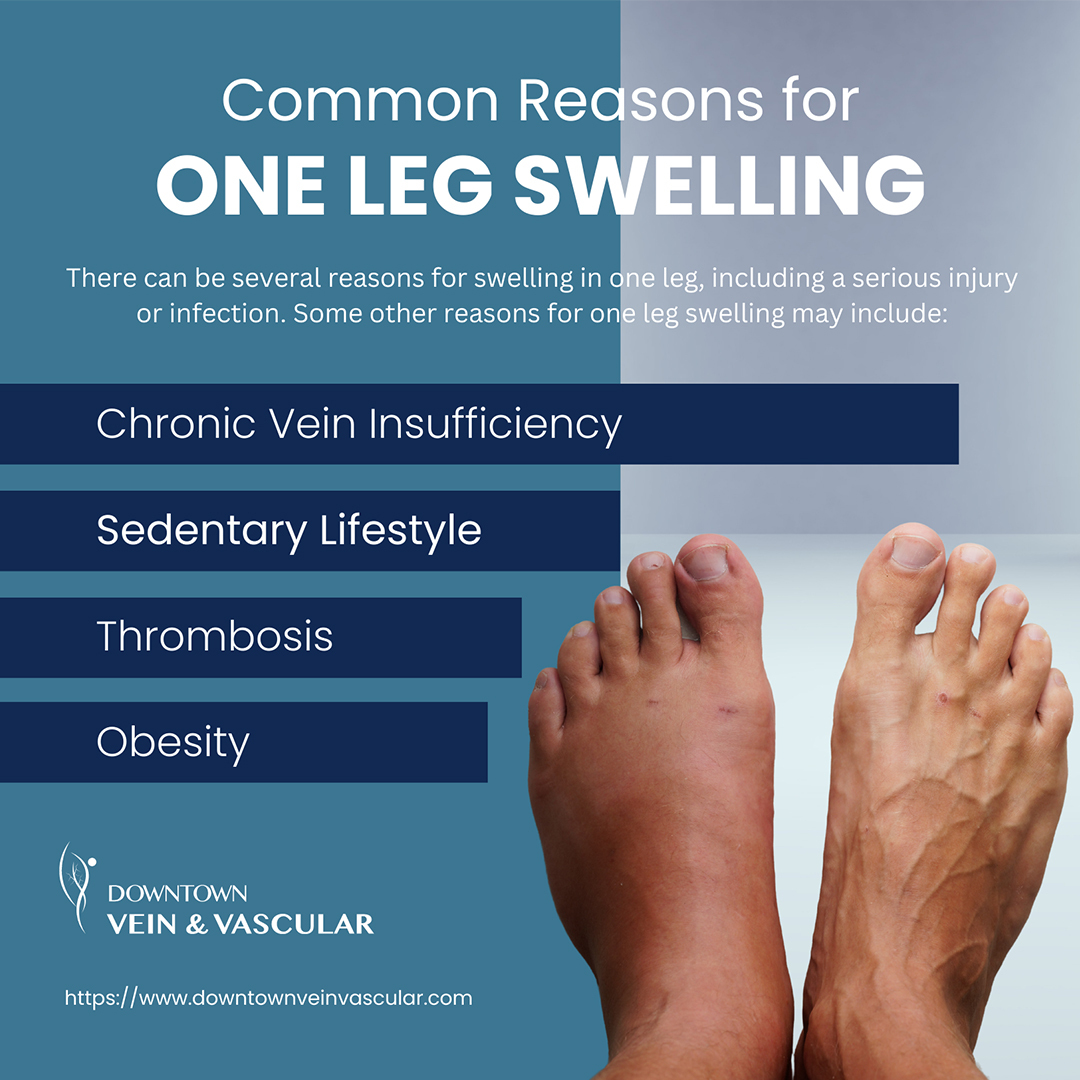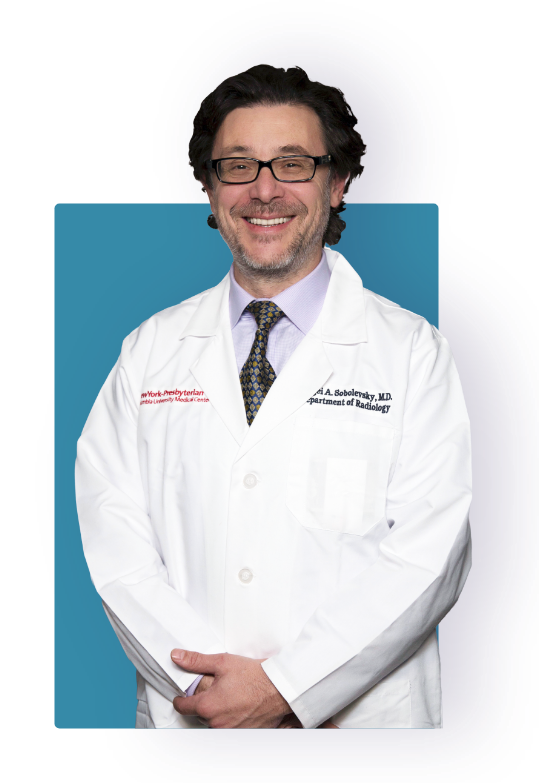Swelling in one leg or calf without any other symptoms or known causes should not be taken lightly. Schedule an appointment with Dr. Sergei A. Sobolevsky at Downtown Vein & Vascular Center before this leg swelling and pain begins to affect your daily activities and causes further complications. Dr. Sobolevsky is an experienced and board-certified endovascular specialist and uses the latest technology to get to the bottom of the vein issues that may be causing peripheral edema. He offers minimally invasive vein treatment options to reduce swelling in the leg and helps you get back to normal within no time.
Also called edema, swelling is the result of fluid buildup that gets trapped in your body’s tissues. This buildup occurs when the blood vessels in your legs or other parts of the body hold more fluid, and this fluid cannot flow or drain properly. The small blood vessels in the body begin to leak fluid. Edema can affect any part of the body, but it is more likely to show up in the legs and feet, also known as peripheral edema.
Swelling in one leg can be due to obstruction of a deep vein in the leg or some infection or other inflammatory condition, specifically affecting that part of the body. It could also indicate a more serious medical issue. The feet, ankles, and legs are common sites of swelling because of gravity’s effect on the fluids in the human body. Swelling that lasts more than a few days requires medical attention as it could be a warning sign of something serious.
Read more: Can I Have a Baby if I Have Fibroids?
Symptoms of a Swollen Lower Leg
Our legs are gravity dependent. Swelling limited to one leg is often obvious and easy to identify. One leg will appear larger than the other. You may also find it difficult to walk, as the skin over the leg feels tight and stretched out.
Other symptoms include:
- Pain
- Redness or warmth of the lower leg
- Dimples or dents on the skin after pressing on the affected area for a few seconds
- Cramping or soreness
- Feeling of heaviness
- Stretched or shiny skin
- Stiffness
- Limited range of motion
When caused by an injury, swelling in one leg is not threatening. However, if there are no injuries or any sign of infection, swelling in a single leg may be resulting from an underlying condition that requires prompt attention. If you notice any of these symptoms, call your healthcare provider to seek immediate medical help.
Read on to know about the main causes of swelling in a single leg and treatment options.
Some Common Reasons for One Leg Swelling
There can be several reasons for swelling in one leg, including a serious injury or infection. Some other reasons for one leg swelling may include:
Sedentary Lifestyle
If you sit for long hours working on a computer or desk, do not exercise properly, or are mostly inactive, it can take a toll on your body. Too much inactivity or lack of movement can affect the veins in the lower part of the body. Standing or sitting for a longer period makes it difficult for the body to pump back blood to the heart, causing the veins to swell up. A sedentary lifestyle increases your risk of muscle deterioration and pain, poor circulation, blood clotting, and swelling in one or both legs.
Obesity
If you are overweight, the excess body weight puts further pressure on your body and veins. Obesity is a medical problem that increases the risk of other diseases and health problems, including heart disease, diabetes, high blood pressure, and certain cancers. It can also aggravate vein damage, and it could result in swelling in the leg. The swelling can be in both limbs, but often it shows up in one leg.
Thrombosis
If there is a blood clot just beneath the skin’s surface, it can lead to swelling. It is known as superficial vein thrombosis (SVT). If this condition is not diagnosed and treated timely, it can lead to a more critical issue, deep vein thrombosis (DVT). A clot deep in the veins of the lower leg is very dangerous as it can break loose from the leg and travel up to your heart or lung, resulting in life-threatening consequences.
Swelling in one leg, especially the calf, as blood pools in this area is one of the first symptoms of DVT or thrombophlebitis, an inflammatory process that causes a blood clot to form and block one or more veins, usually in the legs. Leg pain, tenderness or cramping, and skin that begins to turn red or blue and feels warm to the touch are some common symptoms you may experience in case of blood clots.
Chronic Vein Insufficiency
When the valves inside the leg veins do not keep the blood flowing towards your heart, it can lead to backup and collection of blood in the lower legs. Venous insufficiency causes dilated veins that can lead to either spider or varicose veins, along with leg swelling that often worsens with time. You will notice a reddish or blueish cluster of veins on your skin, along with swelling in one leg.

Read more: Why Do My Legs Feel Heavy, and How Can I Get This Cured?
Preventing Swelling in a Single Leg
Here are some remedies you can follow at home to alleviate swelling in your leg:
- Wear loose-fitting clothing and avoid tight and restricted pants
- If you sit for a longer period, keep your legs elevated
- If you have been prescribed any medication for leg swelling, take it as recommended by the doctor
- If you suffer from varicose veins, take frequent breaks, get up, and go for short walks multiple times a day
- Try wearing support socks to keep the swelling down
- Wear compression socks if your healthcare provider approves
These tips help keep the swelling down and keep you active. However, it is necessary to remember that any form of leg swelling that does not go away with home remedies, causes further pain, or is accompanied by other unusual symptoms should be promptly checked by a doctor. It may be a sign of an underlying medical issue that needs to be further investigated.
A swollen leg is not the type of thing you should wait to heal on its own, as it may not go away easily. It may be due to an underlying chronic condition, resulting from medications you are taking or as an aftereffect of surgery. A top vein specialist near you, Dr. Sergei A. Sobolevsky offers excellent vein treatment options that safely and effectively address most causes of swollen legs and ensure long-term relief. You can look forward to the highest level of care and vein therapy solutions that improve your quality of life and prevent serious complications resulting from vascular issues.

Sergei Sobolevsky, MD, is a leading specialist in endovascular medicine with experience in vascular and interventional radiology. Dr. Sobolevsky has decades of experience in the field, with over 25,000 procedures performed, accumulating extensive experience in image-guided minimally invasive medicine, diagnosing and treating a range of conditions.
Dr. Sobolevsky earned his Doctor of Medicine (MD) degree in 1997 from the University of Colorado School of Medicine. He received his specialty clinical training in vascular and interventional radiology at Harvard University. Later, he earned his MBA from the MIT Sloan School of Management. Recognized as a Castle Connolly Top Doctor and named to the Top Doctors New York Metro Area in 2020, 2021, and 2022, Dr. Sobolevsky is licensed in multiple states, has delivered presentations at numerous institutions in the US and abroad, and now acts as a clinical advisor for the biomedical industry. He also held multiple positions in the field during his career, including Chief of Vascular and Interventional Radiology at the Columbia University Medical Center in New York, NY, Senior Vice President in Clinical and Regulatory Affairs at Artann Laboratories in North Brunswick, NJ, and Medical Director at the American Endovascular and Amputation Prevention Center in Brooklyn.
More About Dr. Sobolevsky

